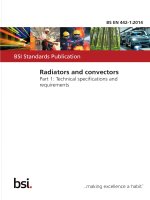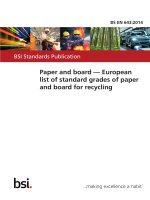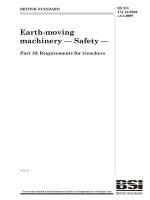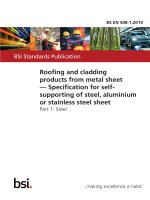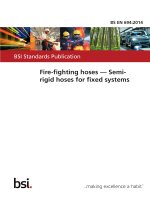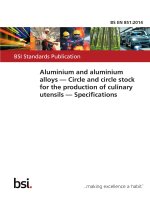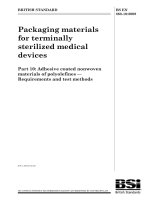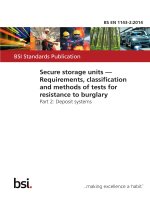Bsi bs en 16603 35 10 2014
Bạn đang xem bản rút gọn của tài liệu. Xem và tải ngay bản đầy đủ của tài liệu tại đây (1.4 MB, 70 trang )
BS EN 16603-35-10:2014
BSI Standards Publication
Space engineering —
Compatibility testing for
liquid propulsion components,
subsystems and systems
BS EN 16603-35-10:2014
BRITISH STANDARD
National foreword
This British Standard is the UK implementation of EN
16603-35-10:2014.
The UK participation in its preparation was entrusted to Technical
Committee ACE/68, Space systems and operations.
A list of organizations represented on this committee can be
obtained on request to its secretary.
This publication does not purport to include all the necessary
provisions of a contract. Users are responsible for its correct
application.
© The British Standards Institution 2014. Published by BSI Standards
Limited 2014
ISBN 978 0 580 84095 1
ICS 49.140
Compliance with a British Standard cannot confer immunity from
legal obligations.
This British Standard was published under the authority of the
Standards Policy and Strategy Committee on 30 September 2014.
Amendments issued since publication
Date
Text affected
BS EN 16603-35-10:2014
EN 16603-35-10
EUROPEAN STANDARD
NORME EUROPÉENNE
EUROPÄISCHE NORM
September 2014
ICS 49.140
English version
Space engineering - Compatibility testing for liquid propulsion
components, subsystems and systems
Ingénierie spatiale - Essais de compatibilité des
composants, sous-systèmes et systèmes de propulsion
liquide
Raumfahrttechnik - Kompatibilitätstests für
Flüssigkeitsantriebe
This European Standard was approved by CEN on 1 March 2014.
CEN and CENELEC members are bound to comply with the CEN/CENELEC Internal Regulations which stipulate the conditions for giving
this European Standard the status of a national standard without any alteration. Up-to-date lists and bibliographical references concerning
such national standards may be obtained on application to the CEN-CENELEC Management Centre or to any CEN and CENELEC
member.
This European Standard exists in three official versions (English, French, German). A version in any other language made by translation
under the responsibility of a CEN and CENELEC member into its own language and notified to the CEN-CENELEC Management Centre
has the same status as the official versions.
CEN and CENELEC members are the national standards bodies and national electrotechnical committees of Austria, Belgium, Bulgaria,
Croatia, Cyprus, Czech Republic, Denmark, Estonia, Finland, Former Yugoslav Republic of Macedonia, France, Germany, Greece,
Hungary, Iceland, Ireland, Italy, Latvia, Lithuania, Luxembourg, Malta, Netherlands, Norway, Poland, Portugal, Romania, Slovakia,
Slovenia, Spain, Sweden, Switzerland, Turkey and United Kingdom.
CEN-CENELEC Management Centre:
Avenue Marnix 17, B-1000 Brussels
© 2014 CEN/CENELEC All rights of exploitation in any form and by any means reserved
worldwide for CEN national Members and for CENELEC
Members.
Ref. No. EN 16603-35-10:2014 E
BS EN 16603-35-10:2014
EN 16603-35-10:2014 (E)
Table of contents
Foreword .................................................................................................................... 5
1 Scope ....................................................................................................................... 6
2 Normative references ............................................................................................. 7
3 Terms, definitions and abbreviated terms.......................................................... 10
3.1
Terms from other standards....................................................................................10
3.2
Terms specific to the present standard ................................................................... 10
3.3
Abbreviated terms...................................................................................................11
4 General requirements for compatibility tests .................................................... 13
4.1
4.2
General...................................................................................................................13
4.1.1
Compatibility test assessment ................................................................... 13
4.1.2
Test conditions ..........................................................................................13
4.1.3
Test duration .............................................................................................13
4.1.4
Criticality ...................................................................................................14
4.1.5
Phasing of tests ........................................................................................14
Compatibility tests...................................................................................................14
4.2.1
Requirement for compatibility testing ........................................................ 14
4.2.2
Compatibility testing of surface treated samples ....................................... 14
4.2.3
Provision COTS components .................................................................... 15
4.2.4
Compatibility testing logic .......................................................................... 15
4.2.5
Compatibility test plan and compatibility test procedure ............................ 16
4.2.6
Accept and reject criteria ........................................................................... 16
4.2.7
Deviations from standards or standard guides .......................................... 16
4.2.8
Execution of tests ......................................................................................16
5 Identification of compatibility problems for liquid propulsion systems .......... 19
5.1
5.2
General...................................................................................................................19
5.1.1
Overview ...................................................................................................19
5.1.2
Compatibility aspects ................................................................................ 19
Ground storage and transport .................................................................................19
5.2.1
2
Ground storage .........................................................................................19
BS EN 16603-35-10:2014
EN 16603-35-10:2014 (E)
5.2.2
5.3
Transport ..................................................................................................20
Known incompatibilities ..........................................................................................20
5.3.1
Table of known incompatibilities ................................................................ 20
5.3.2
General .....................................................................................................20
6 Identification of tests to characterize the compatibility .................................... 21
6.1
6.2
6.3
6.4
6.5
6.6
6.7
Compatibility tests...................................................................................................21
6.1.1
Overview ...................................................................................................21
6.1.2
Safety test .................................................................................................21
6.1.3
Environmental pollution ............................................................................. 21
6.1.4
Test sequence ..........................................................................................22
Pure compatibility tests ...........................................................................................22
6.2.1
Immersion screening tests ........................................................................ 22
6.2.2
Qualitative immersion tests ....................................................................... 23
6.2.3
Immersion characterization tests ............................................................... 25
Material selection corrosion tests ............................................................................ 27
6.3.1
Overview ...................................................................................................27
6.3.2
Red-Ox potential test ................................................................................27
6.3.3
Corrosion potential test ............................................................................. 27
Mechanical properties testing .................................................................................27
6.4.1
Tensile tests ..............................................................................................27
6.4.2
Creep tests ...............................................................................................28
6.4.3
Stress corrosion tests................................................................................28
6.4.4
Verification of crack propagation ............................................................... 29
General corrosion tests ...........................................................................................29
6.5.1
General corrosion .....................................................................................29
6.5.2
Galvanic corrosion test ..............................................................................29
6.5.3
Coupled galvanic corrosion, crevice corrosion and pitting corrosion
tests. .........................................................................................................29
6.5.4
Corrosion of ceramic materials .................................................................. 30
Polymers and ceramics properties change due to liquid exposure tests ................. 30
6.6.1
General .....................................................................................................30
6.6.2
Mechanical properties ...............................................................................30
6.6.3
Volume and mass properties..................................................................... 31
6.6.4
Permeability ..............................................................................................31
Ageing tests ............................................................................................................31
6.7.1
Overview ...................................................................................................31
6.7.2
Ageing of polymers and lubricants ............................................................ 32
3
BS EN 16603-35-10:2014
EN 16603-35-10:2014 (E)
6.7.3
6.8
6.9
Ageing of ceramics....................................................................................33
Dissolution test .......................................................................................................34
6.8.1
Overview ...................................................................................................34
6.8.2
Dissolution of solids in liquids .................................................................... 34
6.8.3
Miscibility of liquids....................................................................................35
6.8.4
Dissolution of gases in liquids ................................................................... 36
Special materials testing .........................................................................................37
6.9.1
Hydrogen embrittlement tests ................................................................... 37
6.9.2
Oxygen compatibility tests......................................................................... 38
6.10 Operational tests ....................................................................................................39
6.10.1
Overview ...................................................................................................39
6.10.2
Provisions .................................................................................................39
7 Deliverables .......................................................................................................... 41
Annex A (normative) Compatibility assessment and applicability report for
liquid propulsion components, subsystems and systems (CAAR) - DRD ..... 42
Annex B (normative) Compatibility Testing for Liquid Propulsion Report
(CTLP) - DRD........................................................................................................ 47
Annex C (normative) Propulsion components and subsystems
compatibility aspects .......................................................................................... 50
Annex D (normative) Known incompatibilities ..................................................... 55
Annex E (informative) Example of tailoring the requirements list for
propulsion systems ............................................................................................ 64
7.2
Use of the compatibility testing flow chart for Liquid Propulsion System
compatibility testing ................................................................................................64
Bibliography............................................................................................................. 66
Figures
Figure 4-1: Compatibility testing flow chart ........................................................................... 18
Figure A-1 : Example of compatibility assessment................................................................ 45
Figure A-2 : Example of compatibility assessment, references ............................................. 46
Tables
Table D-1 : Known incompatibilities ......................................................................................55
4
BS EN 16603-35-10:2014
EN 16603-35-10:2014 (E)
Foreword
This document (EN 16603-35-10:2014) has been prepared by Technical
Committee CEN/CLC/TC 5 “Space”, the secretariat of which is held by DIN.
This standard (EN 16603-35-10:2014) originates from ECSS-E-ST-35-10C.
This European Standard shall be given the status of a national standard, either
by publication of an identical text or by endorsement, at the latest by March
2015, and conflicting national standards shall be withdrawn at the latest by
March 2015.
Attention is drawn to the possibility that some of the elements of this document
may be the subject of patent rights. CEN [and/or CENELEC] shall not be held
responsible for identifying any or all such patent rights.
This document has been prepared under a mandate given to CEN by the
European Commission and the European Free Trade Association.
This document has been developed to cover specifically space systems and has
therefore precedence over any EN covering the same scope but with a wider
domain of applicability (e.g. : aerospace).
According to the CEN-CENELEC Internal Regulations, the national standards
organizations of the following countries are bound to implement this European
Standard: Austria, Belgium, Bulgaria, Croatia, Cyprus, Czech Republic,
Denmark, Estonia, Finland, Former Yugoslav Republic of Macedonia, France,
Germany, Greece, Hungary, Iceland, Ireland, Italy, Latvia, Lithuania,
Luxembourg, Malta, Netherlands, Norway, Poland, Portugal, Romania,
Slovakia, Slovenia, Spain, Sweden, Switzerland, Turkey and the United
Kingdom.
5
BS EN 16603-35-10:2014
EN 16603-35-10:2014 (E)
1
Scope
ECSS-E-ST-35-10 belongs to the propulsion field of the mechanical discipline, as
defined in ECSS-S-ST-00, and concerns itself with compatibility testing of
propulsion components, sub-systems and systems.
Compatibility encompasses the interaction of two or more materials, solids (e.g.
structural materials), liquids (e.g. propellants, simulation and cleaning liquids)
or gases (e.g. air, pressurants). In case the interaction has the effect that the
properties of the materials change, there is the possibility of a compatibility
issue.
The standard:
•
identifies materials used in propulsion for which incompatibility can
create problems,
•
identifies the time scale at which problems can occur. It makes a
difference whether a system is only stored or operational for a short
period and is to function only during launch (time scale measured in
months) and systems that have a long life in orbit (time scale measured in
years),
•
identifies the liquid propulsion components, subsystems and systems to
be subject to compatibility testing,
•
identifies, specifies and defines the tests, test conditions and
compatibility test procedures to ensure that representative compatibility
testing can take place, and
•
establishes the test requirements.
The standard is applicable to the design and the qualification of liquid
propulsion components, sub-systems and systems and can be applied to their
development; it also applies to COTS items procured for the propulsion system.
From the tests described in this standard the effects of interactions of space
propulsion materials and fluids on the components, subsystems and systems
can be established. In this way it can be assured that the component, subsystem
or system satisfies the requirements.
This standard is limited to tests on component-, subsystem- and system-level.
Only for those cases where new materials, substances or conditions are
involved for which there is no experience or data available, the performance of
screening tests is specified.
This standard may be tailored for the specific characteristic and constrains of a
space project in conformance with ECSS-S-ST-00.
6
BS EN 16603-35-10:2014
EN 16603-35-10:2014 (E)
2
Normative references
The following normative documents contain provisions which, through
reference in this text, constitute provisions of this ECSS Standard. For dated
references, subsequent amendments to, or revision of any of these publications
do not apply, However, parties to agreements based on this ECSS Standard are
encouraged to investigate the possibility of applying the more recent editions of
the normative documents indicated below. For undated references, the latest
edition of the publication referred to applies.
EN reference
Reference in text
Title
EN 16601-00-01
ECSS-S-ST-00-01
ECSS system – Glossary of terms
EN 16603-32
ECSS-E-ST-32
Space engineering – Structural general requirements
EN 16603-32-10
ECSS-E-ST-32-10
Space engineering – Structural factors of safety for
spaceflight hardware
EN 16603-35
ECSS-E-ST-35
Space engineering – Propulsion general requirements
EN 16603-35-06
ECSS-E-ST-35-06
Space engineering – Cleanliness requirements for
spacecraft propulsion hardware
EN 16602-70-36
ECSS-Q-ST-70-36
Space product assurance – Material selection for
controlling stress-corrosion cracking
EN 16602-70-37
ECSS-Q-ST-70-37
Space product assurance – Determination of the
susceptibility of metals to stress-corrosion cracking
EN 16602-70-45
ECSS-Q-ST-70-45
Space product assurance – Mechanical testing of
metallic materials
ASTM C 1291-00a
Standard Test Method for Elevated Temperature
Tensile Creep Strain, Creep Strain Rate, and Creep
Time-to-Failure for Advanced Monolithic Ceramics
ASTM C 1337-96
Standard Test Method for Creep and Creep Rupture
of Continuous Fiber-Reinforced Ceramic Composites
under Tensile Loading at Elevated Temperatures
ASTM C 1368-06
Standard Test Method for Determination of Slow
Crack Growth Parameters of Advanced Ceramics by
Constant Stress-Rate Flexural Testing at Ambient
Temperature
ASTM C 1465-08
Standard Test Method for Determination of Slow
Crack Growth Parameters of Advanced Ceramics by
Constant Stress-Rate Flexural Testing at Elevated
7
BS EN 16603-35-10:2014
EN 16603-35-10:2014 (E)
Temperatures
8
ASTM C 1576-05
Standard Test Method for Determination of Slow
Crack Growth Parameters of Advanced Ceramics by
Constant Stress Flexural Testing (Stress Rupture) at
Ambient Temperature
ASTM D 395
Test Methods for Rubber Property—Compression Set
ASTM D 570-98
Standard Test Method for Water Absorption of
Plastics
ASTM D 624-00
Standard Test Method for Tear Strength of
Conventional Vulcanized Rubber and Thermoplastic
Elastomers
ASTM D 638-03
Standard Test Method for Tensile Properties of
Plastics
ASTM D 1434-82
(Reapproved 2003)
Standard Test Method for Determining Gas
Permeability Characteristics of Plastic Film and
Sheeting
ASTM D 2240-04
Standard Test Method for Rubber Property –
Durometer Hardness
ASTM G 4-95
Standard Guide for Conducting Corrosion Coupon
Tests in Field Applications
ASTM G 31-72
(Reapproved 1999)
Standard Practice for Laboratory Immersion
Corrosion Testing of Materials
ASTM G 71-81
(reapproved 1998)
Standard Guide for Conducting and Evaluating
Galvanic Corrosion Tests in Electrolytes.
ASTM G 72-01
Standard Test Method for Autogenous Ignition
Temperature of Liquids and Solids in a HighPressure Oxygen-Enriched Environment
ASTM G 86-98a
Standard test method for Determining Ignition
Sensitivity of Materials to Mechanical Impact in
Ambient Liquid Oxygen and Pressurized Liquid and
Gaseous Oxygen Environments
ASTM G 111-97
Standard Guide for Corrosion Tests in High
Temperature or High Pressure Environment, or Both
ASTM G 142-98
Standard Test Method for Determination of
Susceptibility of Metals to Embrittlement in
Hydrogen Containing Environments at High
Pressure, High Temperature, or Both
ISO 175
Plastics; Methods of Tests for the Determination of the
Effects of Immersion in Liquid Chemicals
ISO 1817, 3rd edition
1999-03-01
Rubber, vulcanized – Determination of the effect of
liquids
ISO 10297
Transportable gas cylinders — Cylinder valves —
Specification and type testing
ISO 15859-1
Space systems – Fluid characteristics sampling and
test methods - Oxygen
BS EN 16603-35-10:2014
EN 16603-35-10:2014 (E)
ISO 15859-7
Space systems – Fluid characteristics sampling and
test methods – Hydrazine
ISO 21010
Cryogenic vessels — Gas/materials compatibility
NACE TM0499-99 Item Standard Test Method Immersion Corrosion Testing
No. 21239
of Ceramic Materials
9
BS EN 16603-35-10:2014
EN 16603-35-10:2014 (E)
3
Terms, definitions and abbreviated terms
3.1
Terms from other standards
For the purpose of this Standard, the terms and definitions from ECSS-ST-00-01
and ECSS-E-ST-35 apply.
For the purpose of this Standard, the following term from ECSS-E-ST-32
applies:
maximum expected operating pressure (MEOP)
For the purpose of this Standard, the following term from ECSS-Q-ST-70-36
applies:
stress corrosion
3.2
Terms specific to the present standard
3.2.1
ageing
entirety of all changes in chemical and physical characteristics occurring in a
material in the course of time
3.2.2
auto ignition temperature
lowest temperature at which a substance produces hot-flame ignition in the
environment and at the pressure without the aid of an external energy source
3.2.3
compatibility
absence of unacceptable performance or reliability loss due to chemical
reactions and physical changes in materials or substances during the
compatibility life
3.2.4
NOTE 1
Compatibility always involves two or more
materials in contact with each other.
NOTE 2
Compatibility is always related
application and the requirements.
to
the
compatibility life
life cycle from the first exposure of two or more materials to each other until
disposal
10
BS EN 16603-35-10:2014
EN 16603-35-10:2014 (E)
3.2.5
contaminant gas
undesired gas present in the propulsion system at any time in its life
3.2.6
corrosion
reaction of the engineering material with its environment with a consequent
deterioration in properties of the material
3.2.7
dissimilar metals
metals with different electrochemical potentials
3.2.8
galvanic corrosion
corrosion as a result of an electrochemical potential difference between
electrical conductors in an electrolyte
3.2.9
hydrogen embrittlement
condition of low ductility or reduced mechanical properties resulting from the
absorption of hydrogen
NOTE
stress intensity factor, K
factor describing the stress state near the tip of a crack caused by a remote load,
residual stress or both.
NOTE
The magnitude of K depends on sample
geometry, the size and location of the crack,
and the magnitude and the modal distribution
of loads on the material. K = σ ⋅ Y ⋅ π ⋅ a
where:
3.3
a
half the crack length
K
stress intensity factor
Y
dimensionless geometrical function
σ
applied stress
Abbreviated terms
For the purpose of this Standard, the abbreviated terms from ECSS-S-ST-00-01
and the following apply:
Abbreviation
Meaning
CAAR
compatibility assessment and applicability report
COTS
commercial of-the-shelf
CPE
chlorinated poly ethylene
CTLP
compatibility testing for liquid propulsion
DSC
differential scanning calorimeter
EPDM
ethylene propylene diene monomer
EPR
ethylene propylene rubber
11
BS EN 16603-35-10:2014
EN 16603-35-10:2014 (E)
GOx
gaseous oxygen
LOx
liquid oxygen
MMH
mono methyl hydrazine
MON
mixed oxides of nitrogen
(MON-X is X% NO and (100-X) % of N2O4
12
NVR
non-volatile residue
PVC
poly vinyl chloride
SEM
scanning electron microscope
SS
stainless steel
TGA
thermal gravimetric analysis
BS EN 16603-35-10:2014
EN 16603-35-10:2014 (E)
4
General requirements for compatibility
tests
4.1
General
4.1.1
a.
The supplier shall analyse and define the conditions for the compatibility
tests with respect to the application and the requirements for the
component, sub-system or system and define them in conformance with
the DRD in Annex A.
4.1.2
a.
Compatibility test assessment
Test conditions
Compatibility testing shall take place under conditions reproducing the
actual use of the items.
NOTE
b.
The extent of compatibility testing shall comply with the reliability
requirements for the component, subsystem or system.
4.1.3
a.
For example: The test items treatments,
processes and handling, to be the same as those
for the actual flight hardware items.
Test duration
The duration of the compatibility test shall be established using the
compatibility life and mission reliability requirements
NOTE 1
The type of information to be obtained for the
component, subsystem or system is e.g. a quick
first impression or an impression based on an
exposure under well controlled conditions with
detailed and precise measurements.
NOTE 2
For short compatibility lives (e.g. as for launchers),
the duration of compatibility tests can be the same
as the compatibility life or somewhat larger. For
large compatibility lives (e.g. satellites in orbit)
accelerated compatibility tests can be used.
13
BS EN 16603-35-10:2014
EN 16603-35-10:2014 (E)
4.1.4
a.
Criticality
In Phase A and in Phase B the following shall be performed:
1.
establish which compatibility problems are expected, or where
there is a lack of information;
2.
ranking of the severity of the compatibility problems;
3.
assess and report the criticality and the effect on material selection
and planning in conformance with Annex A.
NOTE
4.1.5
a.
Phasing of tests
The compatibility tests of clauses 4.2 and 5.1.2 shall be performed early
during project Phase B.
NOTE
4.2
This requirement is included in order that a
proper material selection can be made, and that
a proper data base can be established for the
PDR. The priority and the planning of the tests
is based on their duration or on those
combinations
of
materials
where
the
compatibility problems have been ranked
severe.
Compatibility tests
4.2.1
a.
Requirement for compatibility testing
Compatibility testing of material combinations in propulsion systems
shall be done in case there is no experimental or historical evidence that
the combination meets the compatibility requirements.
NOTE
b.
a.
This includes simulation and cleaning fluids,
purging gases and cleaning and drying
processes.
The need for compatibility testing shall be assessed and included in
Annex A.
4.2.2
14
The severity of the compatibility issue can lead to
intensive
investigations
(new
materials,
development risks), which can endanger the
development schedule.
Compatibility testing of surface treated
samples
Samples of surface treated materials for propulsion systems, where there
is no evidence that they meet the compatibility life, shall undergo
compatibility testing.
BS EN 16603-35-10:2014
EN 16603-35-10:2014 (E)
b.
‘Untreated’ parts of the samples shall be insulated or protected in such a
way that they do not disturb the measurements or cause false
information.
NOTE
Surface treatment of materials is done for
various reasons, amongst which improving the
material compatibility characteristics. Typical
surface treatments encompass passivation /
chemical etching, anodising, polishing, coating
such as: painting, plating, vacuum spraying /
vacuum deposition, electro-deposition, organic
coating, or changing surface properties by
chemical
adsorption
(e.g.
nitration,
carbonization).
4.2.3
Provision COTS components
4.2.3.1
General
a.
It shall be demonstrated that COTS components meet the compatibility
life requirement.
NOTE
4.2.3.2
For cost or time reasons COTS components can
be selected for propulsion systems. If there is
no certainty that all components of the COTS
components
meet
the
compatibility
requirements, solutions are sought (e.g.
redesign, surface treatment, replacement,
requalification).
Surface treatment of COTS components
a.
If a component has undergone a surface treatment to meet the
compatibility requirements, this component shall undergo compatibility
testing in conformance with clauses 4.1.2 and 4.1.3.
b.
Modified COTS components shall undergo re-qualification and full
functional testing to ensure its functionality according to clause 6.10.
4.2.4
Compatibility testing logic
a.
For completely unknown material combinations that involve energetic
materials or materials for which the possibility exists of generating toxic
or poisonous materials, safety tests shall be performed before starting
compatibility testing, see clause 6.1.2.
b.
Compatibility testing should take place following the logic of Figure 4-1
NOTE 1
This guarantees that they are performed with
increasing complexity, generation of details,
and for the specific applications.
NOTE 2
The requirements list needs to be tailored. It
depends on the specific application which tests
are going to be performed and which by-
15
BS EN 16603-35-10:2014
EN 16603-35-10:2014 (E)
passed: e.g. if no hydrogen is involved, no
hydrogen embrittlement tests are performed.
NOTE 3
4.2.5
a.
b.
1.
establishing a compatibility test plan in conformance with the
elements identified in Annex B,
2.
establishing a compatibility test procedure in conformance with
the elements identified in Annex B,
3.
assessing the results.
In case no specific procedures have been identified in this standard, the
compatibility test plan and compatibility test procedure shall be agreed
with the customer.
NOTE 1
Accept and reject criteria judge the quality of
the test itself as well as whether the material
combinations
meet
the
compatibility
requirements.
NOTE 2
A ‘grey zone’ in the accept / reject criteria
requires consultation with the customer.
Deviations from standards or standard
guides
All deviations shall be identified, agreed with the customer and
described in the compatibility test procedure 4.2.5a.2.
4.2.8
Execution of tests
4.2.8.1
Laboratories
a.
16
Accept and reject criteria
For every propulsion compatibility test, accept and reject criteria shall be
established.
4.2.7
a.
Compatibility test plan and compatibility
test procedure
For every propulsion compatibility test the following shall be performed:
4.2.6
a.
An example of tailoring the requirements list is
given in Annex C and Annex E.
The laboratories performing the compatibility tests shall provide
documented evidence that
1.
they are certified to perform these tests, or
2.
they are well experienced in the foreseen tests.
BS EN 16603-35-10:2014
EN 16603-35-10:2014 (E)
4.2.8.2
a.
Personnel
For the personnel executing the tests documented evidence shall be
provided showing that
1.
the personnel is certified to perform these tests or
2.
the personnel is well experienced to perform these tests.
17
BS EN 16603-35-10:2014
EN 16603-35-10:2014 (E)
Medium: (Propellant or simulant in solid, liquid or vapour form)
Metallic solid
material
Ceramic solid
material
Polymeric solid
material
Liquid material
Gaseous material
Safety Tests (Clause 6.1.2)
PURE COMPATIBILITY TESTS (Clause 6.2)
Immersion Screening Tests (Clause 6.2.1)
Qualitative Immersion Tests (Clause 6.2.2)
Immersion Characterization Tests (Clause 6.2.3)
MATERIAL SELECTION CORROSION TESTS (Clause 6.3)
Red-Ox Potential Tests
(Clause 6.3.2)
Corrosion Potential Tests
(Clause 6.3.3)
POLYMERS AND CERAMICS
PROPERTIES CHANGE DUE TO
EXPOSURE TESTS (Clause 6.6)
Mechanical Properties
(Clause 6.6.2)
Volume and mass properties
(Clause 6.6.3)
MECHANICAL PROPERTIES TESTS
(Clause 6.4)
Permeability (Clause
6.6.4)
Tensile Tests (Clause 6.4.1)
Creep Tests (Clause 6.4.2)
Stress Corrosion Tests (Clause 6.4.3)
Verification of Crack Propagation
(Clause 6.4.4)
GENERAL CORROSION TESTS (6.5)
General Corrosion (Clause 6.5.1)
Galvanic Corrosion Test (Clause 6.5.2)
Coupled galvanic corrosion, crevice
corrosion and pitting corrosion tests.
(Clause 6.5.3)
AGEING TESTS (Clause 6.7)
Ageing of
Ceramics
(Clause 6.7.3)
Ageing of Polymers and
lubricants
(Clause 6.7.2)
DISSOLUTION TESTS (Clause 6.8)
Dissolution of
solids
in liquids
(Clause 6.8.2)
Miscibility of
liquids (Clause
6.8.3)
Corrosion of Ceramic Materials (Clause 6.5.4)
SPECIAL MATERIALS TESTING (Clause 6.9)
Hydrogen Embrittlement Tests
(Clause 6.9.1)
Oxygen Compatibility Tests (Clause 6.9.2)
Imp test w. LOx & GOx (6.9.2.2), Spont. Ing. Test (6.9.2.3), Press. Surge Test (6.9.2.4)
Operational Tests (Clause 6.10)
Figure 4-1: Compatibility testing flow chart
18
Dissolution of
gases in liquids
(Clause 6.8.4)
BS EN 16603-35-10:2014
EN 16603-35-10:2014 (E)
5
Identification of compatibility problems for
liquid propulsion systems
5.1
General
5.1.1
Overview
The objective of Clause 5 is to highlight common propulsion system
compatibility problems that have been experienced in the past. A list of
examples and incompatibilities is given in Annex C and Annex D.
5.1.2
Compatibility aspects
a.
The relevant propulsion configuration shall be analyzed for compatibility
issues using cases and incompatibilities listed in Annex C and Annex D.
b.
In order to assess the effects of incompatibility with contaminated fluids,
e.g. as for external contamination, tests or analyses may be performed for
these specific cases.
NOTE
5.2
For example: 1 mg of copper and 1000 l of
hydrazine.
c.
Compatibility shall be assessed and verified, by similarity, analysis or
test and reported in the CAAR.
d.
It shall be demonstrated that the compatibility tests specified in the
compatibility test plan cover the identified open incompatibilities and
cases provided in Annex C and Annex D.
e.
Test results shall be reported in conformance with Annex B.
Ground storage and transport
5.2.1
Ground storage
5.2.1.1
General
a.
The supplier shall assess and report in conformance with Annex A
compatibility problems due to the state of the propellant originating
from:
19
BS EN 16603-35-10:2014
EN 16603-35-10:2014 (E)
1.
saturation with pressurant gases during pressurized ground
storage;
2.
contamination during storage and transport.
5.2.1.2
a.
Provision
The state of the propellant before loading the launcher or spacecraft, or
before use shall be established to avoid compatibility problems.
NOTE
5.2.2
5.3
Examples of states
saturation level.
are
composition,
gas
Transport
a.
It shall be ensured that corrosion or contamination does not occur during
transport.
b.
Packaging shall be according to ECSS-E-ST-35-06 clause 8.1 ‘Approved
coverings’.
c.
The output of 5.2.2 a and 5.2.2 b shall be reported in conformance with
Annex A.
Known incompatibilities
5.3.1
Table of known incompatibilities
In Annex D a table of known incompatibilities is given (Table D-1). The
objective of this table is to highlight which combinations of materials used in
liquid propulsion have shown incompatibilities. Whether or not material
combinations are considered to be incompatible depends on the compatibility
life. The table only identifies short-term incompatibility (order of months) and
long-term incompatibility (order of several years). The table is neither
exhaustive nor complete. References are given where available. If a material
combination is not mentioned in Table D-1 this does not imply that the
combination is compatible.
It is important to check the references to obtain more detailed information on
the conditions under which the incompatibility has been established.
5.3.2
a.
20
General
If material combinations are selected that appear in Table D-1 for the
planned duration and conditions, the risks of using this combination
shall be analysed.
BS EN 16603-35-10:2014
EN 16603-35-10:2014 (E)
6
Identification of tests to characterize the
compatibility
6.1
Compatibility tests
6.1.1
Overview
Material tests encompass a number of tests performed to establish whether
certain combinations of materials or substances are compatible under the
conditions envisaged for the foreseen propulsion application.
The initial compatibility tests are qualitative tests, simple and fast that serve to
establish if combinations are not compatible.
6.1.2
Safety test
a.
The safety regulations of the laboratory where the tests are being
performed shall be observed.
b.
In case of unknown or new materials or substances, clause 4.2.4a and
6.1.2c shall apply.
c.
A safety test may be performed by bringing small quantities of the
substances into contact with each other under controlled conditions in a
safety cabinet.
NOTE
6.1.3
a.
The safety test is not a compatibility test, but a
test that ensures that personnel and equipment
is not endangered and has to follow the local
safety regulations. As it is not a compatibility
test, it is not dealt with in detail in this
standard.
Environmental pollution
The national regulations with regard to pollution and protection of the
environment shall be observed when tests are executed.
21
BS EN 16603-35-10:2014
EN 16603-35-10:2014 (E)
6.1.4
Test sequence
6.1.4.1
General
a.
In case of unknown or new materials or substances, the sequence of
compatibility test shall be as follows:
1.
the immersion screening test.
2.
if 6.1.4.1a.1 is successful, then the immersion screening test.
NOTE
6.1.4.2
Test conditions
a.
In case a mixture of two liquids is screened the mixture shall be
submitted to a safety test according to clause 6.1.2a before undergoing
the compatibility screening test according to clause 6.8.3.1.
b.
The sample conditions shall represent the conditions in actual use in the
propulsion system.
6.1.4.3
6.2
Qualitative immersion tests are of somewhat
longer duration and generate some numerical
and chemical data about the compatibility of
the combination that has been investigated.
Tests
a.
Exposure of the material to the fluid for two hours at ambient
temperature and pressure shall not generate any visible effects or
changes in either the material or the fluid.
b.
The test results shall be reported according to Annex B.
Pure compatibility tests
6.2.1
Immersion screening tests
6.2.1.1
Overview
The immersion screening test is applicable for initially determining reactions
between fluids and materials used in propulsion systems. The sample is
immersed in the fluid.
6.2.1.2
a.
Test condition
The sample conditions shall be the same as those foreseen in actual use in
the propulsion system.
NOTE
22
Examples so sample conditions are: surface
conditions, cleanliness, manufacturing process,
and passivation.
BS EN 16603-35-10:2014
EN 16603-35-10:2014 (E)
6.2.1.3
a.
Tests
Exposure of the material to the fluid for two hours at ambient
temperature and pressure shall not generate any visible effects or
changes in either the material or the fluid.
6.2.2
Qualitative immersion tests
6.2.2.1
Overview
The objective of the immersion test is to quickly identify changes in the fluid
and material qualitatively from exposure of a material to a fluid, both used in
liquid propulsion systems.
NOTE
6.2.2.2
a.
Test activities
The compatibility test procedure shall include:
1.
preparation of the specimen;
2.
the test temperature or test temperatures;
3.
the test pressure or test pressures;
4.
the inert gas to blanket or pressurize the container;
5.
the duration of the test;
6.
the selection of the test container:
7.
b.
The duration of an immersion test is in the
order of days to a few weeks.
(a)
including the size of the test specimen and the amount of
fluid (ratio of the surface of the specimen to the volume of
the fluid);
(b)
specifying the test temperatures and pressures;
(c)
specifying its material and surface preparation;
(d)
being inert with respect to the test specimen and fluid;
(e)
specifying the applicable safety procedures and measures.
the preparation of the container, including the:
(a)
internal surface;
(b)
cleanliness;
(c)
dryness;
(d)
leak tightness;
(e)
requirements for inert gas blanketing;
(f)
instrumentation.
In case of fluids that are known to auto decompose, a reference test shall
be performed and included in the procedure specified in 6.2.2.2a, with
the fluid only present for the envisaged immersion test duration.
23


